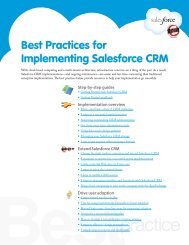Database.com Metadata API Developer's Guide - Salesforce.com
Database.com Metadata API Developer's Guide - Salesforce.com
Database.com Metadata API Developer's Guide - Salesforce.com
You also want an ePaper? Increase the reach of your titles
YUMPU automatically turns print PDFs into web optimized ePapers that Google loves.
GlossaryMany-to-Many RelationshipA relationship where each side of the relationship can have many children on the other side. Many-to-many relationshipsare implemented through the use of junction objects.Master-Detail RelationshipA relationship between two different types of records that associates the records with each other. For example, invoicestatements have a master-detail relationship with line items. This type of relationship affects record deletion and security.<strong>Metadata</strong>Information about the structure, appearance, and functionality of an organization and any of its parts. Force.<strong>com</strong> usesXML to describe metadata.<strong>Metadata</strong> WSDLA WSDL for users who want to use the Force.<strong>com</strong> <strong>Metadata</strong> <strong>API</strong> calls.MultitenancyNAn application model where all users and apps share a single, <strong>com</strong>mon infrastructure and code base.NamespaceOObjectIn a packaging context, a one- to 15-character alphanumeric identifier that distinguishes your package and its contentsfrom packages of other developers onAppExchange, similar to a domain name. <strong>Database</strong>.<strong>com</strong> automatically prependsyour namespace prefix, followed by two underscores (“__”), to all unique <strong>com</strong>ponent names in your <strong>Database</strong>.<strong>com</strong>organization.An object allows you to store information in your <strong>Database</strong>.<strong>com</strong> organization. The object is the overall definition of thetype of information you are storing. For example, the case object allow you to store information regarding customerinquiries. For each object, your organization will have multiple records that store the information about specific instancesof that type of data. For example, you might have a case record to store the information about Joe Smith's training inquiryand another case record to store the information about Mary Johnson's configuration issue.Object-Level SecuritySettings that allow an administrator to hide whole objects from users so that they don't know that type of data exists.Object-level security is specified with object permissions.onClick JavaScriptJavaScript code that executes when a button or link is clicked.One-to-Many RelationshipA relationship in which a single object is related to many other objects. For example, an invoice statement may have oneor more line items.Organization-Wide DefaultsSettings that allow you to specify the baseline level of data access that a user has in your organization. For example, youcan set organization-wide defaults so that any user can see any record of a particular object that is enabled via their objectpermissions, but they need extra permissions to edit one.Outbound MessageAn outbound message is a workflow action that sends the information you specify to an endpoint you designate, suchas an external service. An outbound message sends the data in the specified fields in the form of a SOAP message to the183
















